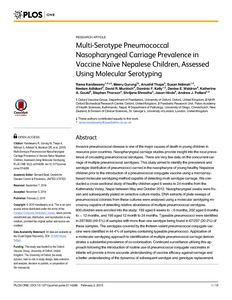Kandasamy, R;
Gurung, M;
Thapa, A;
Ndimah, S;
Adhikari, N;
Murdoch, DR;
Kelly, DF;
Waldron, DE;
Gould, KA;
Thorson, S;
et al.
Kandasamy, R; Gurung, M; Thapa, A; Ndimah, S; Adhikari, N; Murdoch, DR; Kelly, DF; Waldron, DE; Gould, KA; Thorson, S; Shrestha, S; Hinds, J; Pollard, AJ
(2015)
Multi-serotype pneumococcal nasopharyngeal carriage prevalence in vaccine naïve Nepalese children, assessed using molecular serotyping.
PLoS One, 10 (2).
ISSN 1932-6203
https://doi.org/10.1371/journal.pone.0114286
SGUL Authors: Gould, Katherine Ann Hinds, Jason
![[img]](https://openaccess.sgul.ac.uk/107378/1.hassmallThumbnailVersion/Multi_serotype_pneumococcal_nasopharyngeal_carriage_prevalence_vaccine_Nepalese.pdf)  Preview |
|
["document_typename_application/pdf; charset=binary" not defined]
Published Version
Download (921kB)
| Preview
|
Abstract
Invasive pneumococcal disease is one of the major causes of death in young children in resource poor countries. Nasopharyngeal carriage studies provide insight into the local prevalence of circulating pneumococcal serotypes. There are very few data on the concurrent carriage of multiple pneumococcal serotypes. This study aimed to identify the prevalence and serotype distribution of pneumococci carried in the nasopharynx of young healthy Nepalese children prior to the introduction of a pneumococcal conjugate vaccine using a microarray-based molecular serotyping method capable of detecting multi-serotype carriage. We conducted a cross-sectional study of healthy children aged 6 weeks to 24 months from the Kathmandu Valley, Nepal between May and October 2012. Nasopharyngeal swabs were frozen and subsequently plated on selective culture media. DNA extracts of plate sweeps of pneumococcal colonies from these cultures were analysed using a molecular serotyping microarray capable of detecting relative abundance of multiple pneumococcal serotypes. 600 children were enrolled into the study: 199 aged 6 weeks to <6 months, 202 aged 6 months to < 12 months, and 199 aged 12 month to 24 months. Typeable pneumococci were identified in 297/600 (49.5%) of samples with more than one serotype being found in 67/297 (20.2%) of these samples. The serotypes covered by the thirteen-valent pneumococcal conjugate vaccine were identified in 44.4% of samples containing typeable pneumococci. Application of a molecular serotyping approach to identification of multiple pneumococcal carriage demonstrates a substantial prevalence of co-colonisation. Continued surveillance utilising this approach following the introduction of routine use of pneumococcal conjugate vaccinates in infants will provide a more accurate understanding of vaccine efficacy against carriage and a better understanding of the dynamics of subsequent serotype and genotype replacement.
Statistics
Item downloaded times since 23 Apr 2015.
Actions (login required)
 |
Edit Item |



